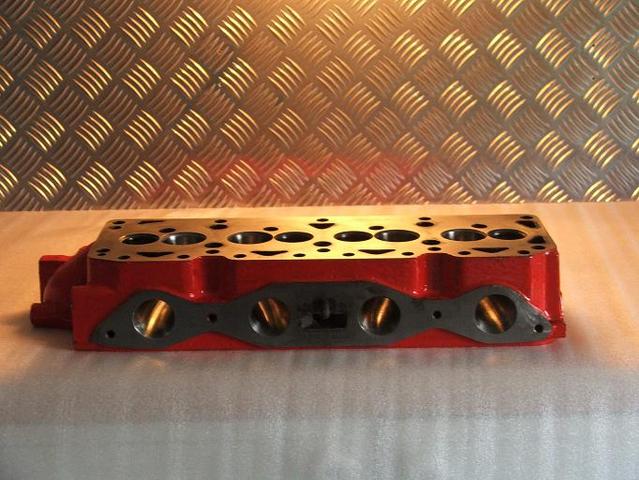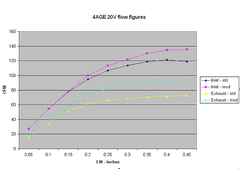Johnmor
|
| posted on 29/11/06 at 07:48 PM |

|
|
port and polish
Has anyone had a go at polishing and porting their cylinder head ( pardon the expresion)
I am considering a heart transplant and can get a 24v engine but it needs some assembly so while am at it I thought I might have a go.
I have ground valves before but not really gone as far as polish or port.
It mat not be worth the effort or is their potential for more damage than benifit.
Opinions please.
http://www.sa-motorsports.com/diyport.shtm
 
|
|
|
|
|
Stu16v
|
| posted on 29/11/06 at 08:17 PM |

|
|
Page cannot be displayed...?
Dont just build it.....make it!
|
|
|
Johnmor
|
| posted on 29/11/06 at 09:15 PM |

|
|
Not sure what i did wrong, if you type it in it works fine.
Basicaly a guide to porting and polishing cylinder heads for the DIY/ Locostbuilder

|
|
|
tks
|
| posted on 29/11/06 at 09:33 PM |

|
|
--
This is him (you gave the name as adress and ignored the link question!)
GOOD Link
Tks
The above comments are always meant to be from the above persons perspective.
|
|
|
jambojeef
|
| posted on 29/11/06 at 11:24 PM |

|
|
I have no experience of doing this myself but have helped a friend do it on a mini cylinder head years ago - it was one of those thigns where owing to
the shape of the inlet and exhaust tracts in the head - it was a total nightmare to actually see what you were removing and make it significantly
better than what was there previously.
What we did do easily and which seemed much better afterwards was that on the mini head there is a cast iron 'shoulder' around 2/3 of the
inlet and exhaust valves which was pretty easily ground back to allow what we thought would be better flow to more of the valve.
Personally I think its a lot of effort for potentially tiny gains.
I think if you have the head off, matching the head to the exhaust and inlet manifolds would be a better thing to do and easier to see what
you're doing...?
Just my 2p worth...
|
|
|
thunderace
|
| posted on 30/11/06 at 01:10 AM |

|
|
i did this myself dont know if it will gime me more bhp but enjoyed doing it ,took me a week lol.
 
Rescued attachment DSCF0375.JPG
|
|
|
Browser
|
| posted on 30/11/06 at 02:31 AM |

|
|
As long as you take your time, make sure all of the ports end up the same shape and don't go mad, why not have a go? If you've got a scrap
head have a go at that first. At the very least, if it's got bronze vavle guides and a big boss cast into the port you can remove the guides,
smooth the boss into the port and then replace the guides. Why not give the ports a nice satin finish when you're done to help airflow. Just
don't do what I did, carve lumps out of the chambers then not check their volume is exactly the same afterwards, it gives you lumpy idle . 
|
|
|
bimbleuk
|
| posted on 30/11/06 at 04:34 AM |

|
|
Yes you can do a lot of harm with little care. However keep it sensible and just tidy up poor casting or smooth off where the valve seats are inserted
in the head as that area can quite bad.
Bottom line is you need a flow bench to check everything you do and the shape of the vavle profile or the valve seat width can have just as much
effect.
I've just spent a chuck of money on my 4AGE 20V head and the results are shown in the chart below. The exhaust ports were quite restrictive hence
the bigger gains.
Max valve lift when assembled would occur around 0.35 lift with standard cams. These figures are max flow potential on a flow bench and only indicate
possible relative gains on a fully assembled engine.
 
Standard v modified 20V cylinder head flow chart.
[Edited on 30/11/06 by bimbleuk]
|
|
|
hughjinjin
|
| posted on 30/11/06 at 10:57 AM |

|
|
I would second the opinions in the last post. There is a real risk that you can decrease rather than increase the flow if you don't know what
you're doing. Remember that the guide on porting that you read was aimed at pre-historic ohv engines and not a modern multi-valve engine like
the Alfa. I'm not trying to say that the Alfa heads can't be imporved but messing about with a flap wheel shoved up the ports will do next
to nothing.
The biggest potential for flow improvement is in the valve seat area and this requires flowbench development or at least someone who is experienced at
doing such work(as well as multi angle valve seat cutters) and is not a diy job.
The biggest restriction to power on the 24v v6 alfa is the inlet tract. Try to get a set of bigger inlet runners (from a 164 cloverleaf I think), junk
the standard flap type afm and run it on megasquirt. that will give you a healthy power increase.
For a good read on porting cylinder heads see David Baker's site at
www.pumaracing.co.uk
He knows what he is talking about and dosen't b/s!
incidentally there is a gtv6 running in the alfa championship with a 3.8l 24v engine with standard heads that is making 350bhp. How much power do you
want!
|
|
|
macnab
|
| posted on 30/11/06 at 11:05 AM |

|
|
I did this on a pinto, good fun and quite quick to do. Just have to get the compression right. It did give a wee bit more poke.
|
|
|
iank
|
| posted on 30/11/06 at 11:33 AM |

|
|
I see pumaracing along with vizard (in his A series book) advise against polishing the chambers.
Vizard is especially critical iirc claiming it reduces power.
|
|
|
Nick Skidmore
|
| posted on 30/11/06 at 11:42 AM |

|
|
Polishing the ports is a no-no, fuel condenses on them. An 80 grit finish keeps the inlet mixture turbulent.
Combustion chamers are often polished as smooth surfaces reflect heat which increases the pressure of combustion liberating more power. That is how I
understand it.
|
NOTE:This user is registered as a LocostBuilders trader and may offer commercial services to other users
|
iank
|
| posted on 30/11/06 at 01:40 PM |

|
|
Maybe, but puma include chambers in their "waste of time" comment (in the general tuning section).
I'll check vizard when I get home, but I don't recall any of the photos in the A series book being polished. If it truly helped I'd
expect all his chambers to look like mirrors 
|
|
|
DarrenW
|
| posted on 30/11/06 at 02:53 PM |

|
|
Several tuners report power increases bu changing the A series chambers but worn you have to know what you are doing and defo need a flow bench.
Pinto tuning books advise aganst modding the pinto combustion chambers unless again you know what you are doing and are seeking the last little bit
from your £10,000 all steel race engine. I enjoyed porting my Pinto head. Took a week of nights but satisfying nevertheless. Cant say if it made any
gains as i did it before car was finished but im sure it cant be worse. I ddint polish anything, pretty sure polished ports dont help and take ages to
do. From my experience its all common sense - try to imagine how the air will flow and where the restrictions are then bland them out. Tight turns and
corners reduce flow, so make them less tight. Tricky bit is making all 4 ports the same. Also pay attention to where manifolds mount - you dont want a
step at this point as again flow will be reduced.
I enjoyed reading Des Hammills book.
|
|
|
MikeRJ
|
| posted on 30/11/06 at 03:03 PM |

|
|
quote:
Originally posted by jambojeef
Personally I think its a lot of effort for potentially tiny gains.
All depends on the enigne. In the case of the small bore A Series you can see large gains simply because the heads on these are pretty crap in
standard form (excessive valve shrouding and poor port shape). In fact it's widly regarded the the head is the most important area to
concentrate on to extract good power from an A series.
On a more modern 16v engine the ports and combustion chamber design are generaly far better straight from the factory, so there is less scope for
improvements by a bit of diy grinding.
|
|
|
NS Dev
|
| posted on 30/11/06 at 03:06 PM |

|
|
that's about right Darren. You just have to remember as well that air has inertia at high velocity, and will fling itself to the outside of
corners etc. Always work on ports where the air will hit hard, and just do a minimum tidy up of the casting where the air will impact less. This then
removes the smallest amount of metal possible, which preserves port velocities, which are very important!
This applies much less on 16v engines of modern design. in fact when i set to on a vauxhall XE cosworth head i didn't really know where to
start, as they are chuffing good to start with! Basically, unless you are fitting bigger valves, there is very little to gain by porting one of those,
and quite a lot to lose. I just thinned down the port splitter and tidied up the casting lines. They are hand finished round the seats where it
matters anyway.
Retro RWD is the way forward...........automotive fabrication, car restoration, sheetmetal work, engine conversion
retro car restoration and tuning
|
|
|













